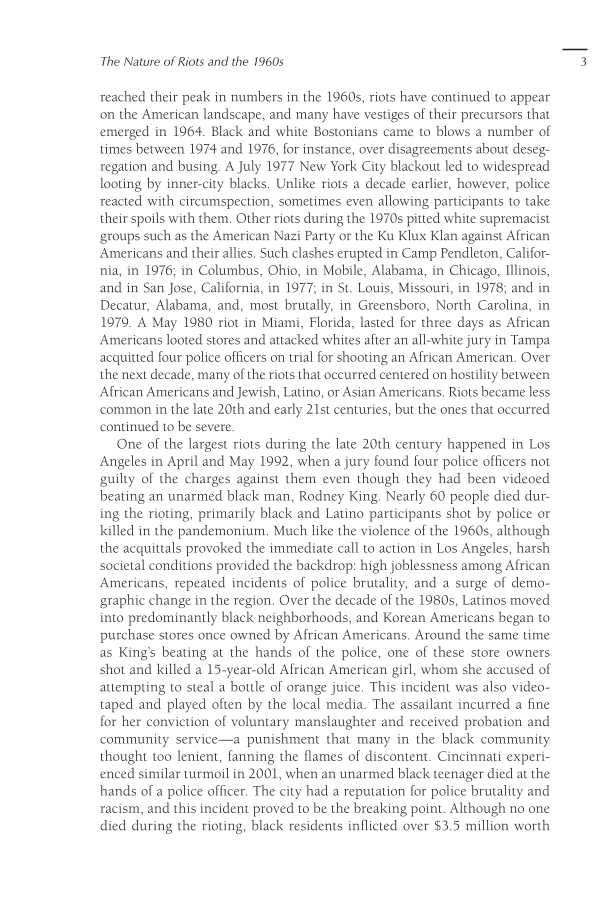The Nature of Riots and the 1960s 3 reached their peak in numbers in the 1960s, riots have continued to appear on the American landscape, and many have vestiges of their precursors that emerged in 1964. Black and white Bostonians came to blows a number of times between 1974 and 1976, for instance, over disagreements about deseg- regation and busing. A July 1977 New York City blackout led to widespread looting by inner-city blacks. Unlike riots a decade earlier, however, police reacted with circumspection, sometimes even allowing participants to take their spoils with them. Other riots during the 1970s pitted white supremacist groups such as the American Nazi Party or the Ku Klux Klan against African Americans and their allies. Such clashes erupted in Camp Pendleton, Califor- nia, in 1976 in Columbus, Ohio, in Mobile, Alabama, in Chicago, Illinois, and in San Jose, California, in 1977 in St. Louis, Missouri, in 1978 and in Decatur, Alabama, and, most brutally, in Greensboro, North Carolina, in 1979. A May 1980 riot in Miami, Florida, lasted for three days as African Americans looted stores and attacked whites after an all-white jury in Tampa acquitted four police officers on trial for shooting an African American. Over the next decade, many of the riots that occurred centered on hostility between African Americans and Jewish, Latino, or Asian Americans. Riots became less common in the late 20th and early 21st centuries, but the ones that occurred continued to be severe. One of the largest riots during the late 20th century happened in Los Angeles in April and May 1992, when a jury found four police officers not guilty of the charges against them even though they had been videoed beating an unarmed black man, Rodney King. Nearly 60 people died dur- ing the rioting, primarily black and Latino participants shot by police or killed in the pandemonium. Much like the violence of the 1960s, although the acquittals provoked the immediate call to action in Los Angeles, harsh societal conditions provided the backdrop: high joblessness among African Americans, repeated incidents of police brutality, and a surge of demo- graphic change in the region. Over the decade of the 1980s, Latinos moved into predominantly black neighborhoods, and Korean Americans began to purchase stores once owned by African Americans. Around the same time as King’s beating at the hands of the police, one of these store owners shot and killed a 15-year-old African American girl, whom she accused of attempting to steal a bottle of orange juice. This incident was also video- taped and played often by the local media. The assailant incurred a fine for her conviction of voluntary manslaughter and received probation and community service—a punishment that many in the black community thought too lenient, fanning the flames of discontent. Cincinnati experi- enced similar turmoil in 2001, when an unarmed black teenager died at the hands of a police officer. The city had a reputation for police brutality and racism, and this incident proved to be the breaking point. Although no one died during the rioting, black residents inflicted over $3.5 million worth
Document Details My Account Print multiple pages
Print
You have printed 0 times in the last 24 hours.
Your print count will reset on at .
You may print 0 more time(s) before then.
You may print a maximum of 0 pages at a time.




















































































































































































